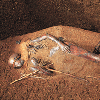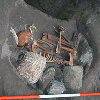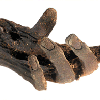

Bog bodies are unusual finds. They attract crowds of visitors to museums and cause great excitement in scientific circles. It is not hard to understand why they arouse so much excitement. Bog bodies provide a window to the past through which we can glimpse things that are only rarely visible.—Wijnand van der Sanden, Through Nature to Eternity
![[image]](https://archive.archaeology.org/1005/bogbodies/images/red_franz.gif)
A Career in the Bogs (online interview, May 2010)
Heather Gill-Robinson tells of her research and interpretation of bog bodies
Bog Bodies Rediscovered (feature, May/June 2010)
True tales from the peat marshes of northern Europe
For more than 10,000 years, peat bogs, mostly in northwestern Europe, have been the final resting place for hundreds, maybe thousands, of bodies. The first reports of their discovery appeared in the 18th century, and they have been found, usually by peat cutters, ever since. There are very old bog bodies—the earliest is the Koelbjerg Woman from Denmark, dated to about 8000 B.C.—medieval bog bodies, and even the remains of Soviet fighter pilot Boris Lazarev, who was shot down over northern Russia in 1943. Only about 20 are as complete as Grauballe Man and Lindow Man; others are just bones or body parts. Many were hastily removed, some improperly conserved or forgotten in museum storage. One was sold at a London auction, and some were even ground up into "mummy powder" and marketed as medication. But many of the most remarkable examples still exist (and a few new ones have surfaced) and continue to fascinate.
 Tollund Man |
 Windeby Girl and Weerdinge Couple |
 Cladh Hallan |
 Red Franz |
 The Girl of Uchter Moor |
 Clonycavan and Old Croghan Men |
Bog Science
Why should a place so damp and fetid—nearly a swamp—preserve anything? It has to do with how inhospitable the conditions in a bog are for the bacteria that usually do the business of decomposition.Beyond Bodies
Human bodies aren't the only residents of northern European bogs. Cold, wet, anoxic, acidic peat also preserves metal, wood, clothing, and leather, among other things.
Mummies, Mugs, and Museum Shops (online feature, August 2005)
Bog body gifts raise questions about using the dead as marketing tools.
Back to the Bog (book review, January/February 2005)
Review of P.V. Glob's The Bog People: Iron-Age Man Preserved
Bodies of the Bogs (online feature, December 1997)
Over the past centuries, remains of many hundreds of people have come to light during peat cutting activities in northwestern Europe.
Violence in the Bogs
Clothing and Hair Styles of the Bog People
Reconstructions
Pathologies of the Bog Bodies
The Oldest of the Bog People
First Bog Body Photographed
Mummy of a Queen?
A Restoration
Advertisement

Advertisement






